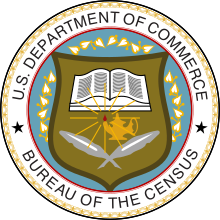
2020 United States census
24th U.S. decennial census / From Wikipedia, the free encyclopedia
Dear Wikiwand AI, let's keep it short by simply answering these key questions:
Can you list the top facts and stats about 2020 United States Census?
Summarize this article for a 10 years old
The 2020 United States census was the 24th decennial United States census. Census Day, the reference day used for the census, was April 1, 2020. Other than a pilot study during the 2000 census,[1] this was the first U.S. census to offer options to respond online or by phone, in addition to the paper response form used for previous censuses.[2]
| Twenty-fourth census of the United States | ||||
|---|---|---|---|---|
| ||||
 Seal of the U.S. Census Bureau | ||||
 | ||||
| General information | ||||
| Country | United States | |||
| Topics | Census topics
| |||
| Authority | U.S. Census Bureau | |||
| Website | www | |||
| Results | ||||
| Total population | 331,449,281 ( | |||
| Most populous | California (39,538,223) | |||
| Least populous | Wyoming (576,851) | |||
The census was taken during the COVID-19 pandemic, which affected its administration. The census recorded a resident population of 331,449,281 in the 50 states and the national capital of Washington, D.C., reflecting an increase of 7.4 percent, or 22,703,743, over that of 2010.[3] The growth rate was the second-lowest ever recorded, and the net increase was the sixth highest in history. This was the first census where the 10 most-populous states each surpassed 10 million residents, and the first census where the 10 most-populous cities each surpassed 1 million residents.
This census' data determined the electoral votes' distribution for the scheduled 2024 United States presidential election.